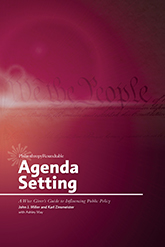Site Search
- resource provided by the Forum Network Knowledgebase.
Search Tip: Search with " " to find exact matches.
ASAE & The Center for Association Leadership's landmark study and publication 7 Measures of Success identified the ability to build effective alliances or partnerships that advance the mission as one of the hallmarks of a remarkable association. But getting a partnership right is an involved undertaking. That's what The Power of Partnership, itself the result of a strategic research collaboration of ASAE & The Center and the U.S. Chamber of Commerce, is all about. The book takes a no-nonsense look at the intricacies of establishing successful partnerships between nonprofit organizations, between nonprofits and for-profit companies, and between nonprofit organizations and governmental entities.
Approximately 45 million foreign-born individuals from all over the world reside in the United States, more than in any other country, comprising nearly 14 percent of the U.S. population.
A 2021 poll from the Cato Institute shows 72 percent of respondents consider immigration to be good for the nation. Yet, many people continue to have complicated and conflicting opinions on the issue, often based on a lack of understanding of how the immigration system operates and exacerbated by disinformation campaigns.
Research helps identify what inspires people to act, while cultural interventions and organizing affect perceptions and how we relate to one another. In this webinar, we will explore the strategies and tactics organizations are deploying to move hearts and minds in support of immigration.
COST: Free for members and nonmembers

Grantmakers occupy a powerful space of privilege in the social change sector. As such, they have a unique opportunity—and responsibility—to work proactively toward equity and inclusivity. Increasingly, grantmaking institutions are challenging themselves to live their values through their grantmaking practices.
For philanthropy to advance equity in all communities, especially low-income communities and communities of color, it needs to be able to understand the demographics of the organizations being funded (and declined), the people being served, and the communities impacted. That data should be used to assess practices and drive decision making.
PEAK Grantmaking is working to better understand and build the capacity of grantmakers for collecting and utilizing demographic data as part of their grantmaking.
In this webinar presented by Grantmakers Concerned with Immigrants and Refugees, funders will learn from experts on the ground about their efforts to champion universal representation and how philanthropy can resource and support their work.
Universal Representation–as a principle and policy objective–ensures that every person, regardless of immigration status, has access to due process. Having access to legal representation makes a sizeable difference in an individual’s case. For example, asylum seekers are five times more likely to win their case for asylum if they have legal counsel. Yet there continue to be systemic inequities, with upwards of 70% of immigration cases lacking legal representation.
Not having an attorney has also been shown to have significant negative effects on the health and well-being of immigrants and their families. Areas of impact can include loss of income, degradation of mental health, and loss of access to medical care. Although having legal representation does not guarantee the outcome of a case, it can reduce harm and ensure that the dignity of individuals is protected.
Across the nation, organizations at the local and state levels are using a variety of tools and approaches to advance the goal of universal representation. In this webinar, funders will learn from experts on the ground about their efforts to champion universal representation and how philanthropy can resource and support their work.
COST: Free for CNJG Members and Non Member Grantmakers

Donating money to modify public thinking and government policy has now taken its place next to service-centered giving as a constructive branch of philanthropy. Many donors now view public-policy reform as a necessary adjunct to their efforts to improve lives directly.
This is perhaps inevitable given the mushrooming presence of government in our lives. In 1930, just 12 percent of U.S. GDP was consumed by government; by 2012 that had tripled to 36 percent. Unless and until that expansion of the state reverses, it is unrealistic to expect the philanthropic sector to stop trying to have a say in public policies.
Sometimes it’s not enough to build a house of worship; one must create policies that make it possible for people to practice their faith freely within society. Sometimes it’s not enough to pay for a scholarship; one must change laws so that high-quality schools exist for scholarship recipients to take advantage of.
Yet public-policy philanthropy has special ways of mystifying and frustrating practitioners. It requires understanding of governmental practice, interpretation of human nature, and some philosophical perspective. Public-policy philanthropists may encounter opponents operating from different principles who view them as outright enemies. Moreover, public-policy struggles never seem to end: victories one year become defeats the next, followed by comebacks, then setbacks, and on and on.
This book was written to help donors navigate all of those obstacles. It draws on deep history and rich interviews with the very best practitioners of public-policy philanthropy in America today. Whatever your aspirations for U.S. society and governance, this guide will help you find the best ways to make a difference.
Nonprofits can and should play an active role during elections, particularly by educating and activating voters. However, with important local, state and federal elections coming up this fall, nonprofits should take the time to remind their staff about appropriate activity during a political campaign or at any other time. This overview developed by Donors Forum provides important tips and examples of activities that are permissible for nonprofits during an election cycle.
